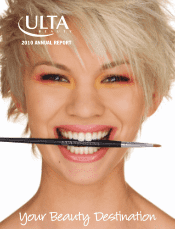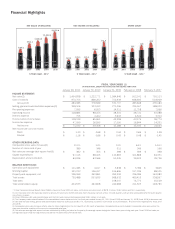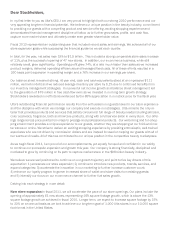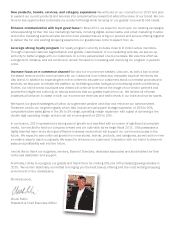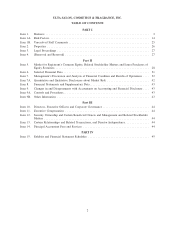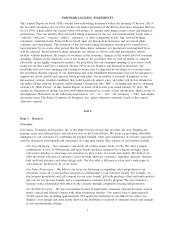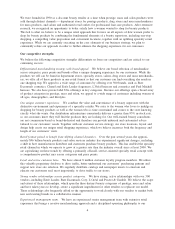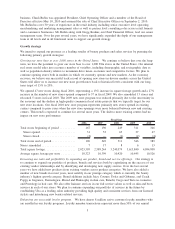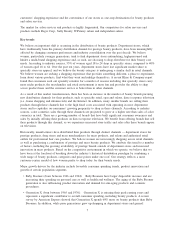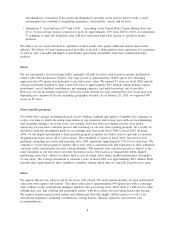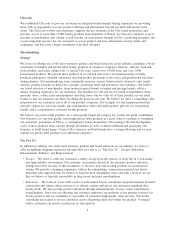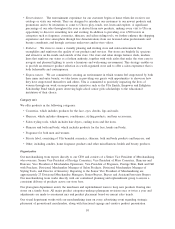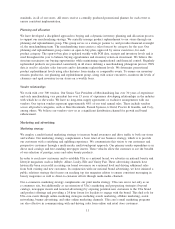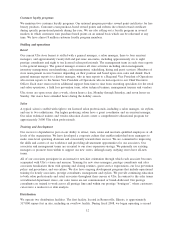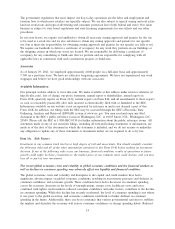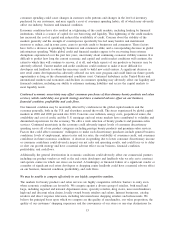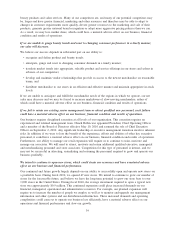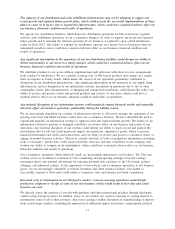Ulta 2010 Annual Report Download - page 11
Download and view the complete annual report
Please find page 11 of the 2010 Ulta annual report below. You can navigate through the pages in the report by either clicking on the pages listed below, or by using the keyword search tool below to find specific information within the annual report.customers’ shopping experience and the convenience of our stores as one-stop destinations for beauty products
and salon services.
The market for salon services and products is highly fragmented. Our competitors for salon services and
products include Regis Corp., Sally Beauty, JCPenney salons and independent salons.
Key trends
We believe an important shift is occurring in the distribution of beauty products. Department stores, which
have traditionally been the primary distribution channel for prestige beauty products, have been meaningfully
affected by changing consumer preferences and industry consolidation over the past decade. We believe
women, particularly younger generations, tend to find department stores intimidating, high-pressured and
hinder a multi-brand shopping experience and, as such, are choosing to shop elsewhere for their beauty care
needs. According to industry sources, 55% of women aged 18 to 24 shop in specialty stores, compared to 40%
of women aged 18 to 64. Over the past ten years, department stores have lost significant market share to
specialty stores in apparel, and we believe the beauty category is undergoing a similar shift in retail channels.
We believe women are seeking a shopping experience that provides something different, a place to experiment,
learn about various products, find what they want and indulge themselves. A recent Kline & Company report
found that consumers seek out specialty retailers for a number of reasons including that specialty stores carry
more niche products, the merchandise and retail environment is more fun and provides the ability to shop
across product lines and the customer service is better than in other channels.
As a result of this market transformation, there has been an increase in the number of beauty brands pursuing
new distribution channels for their products, such as specialty retail, spas and salons, direct response television
(i.e., home shopping and infomercials) and the Internet. In addition, many smaller brands are selling their
products through these channels due to the high fixed costs associated with operating in most department
stores and to capitalize on consumers’ growing propensity to shop in these channels. According to industry
sources, color cosmetics sales through these channels are projected to grow at a higher rate than sales of color
cosmetics in total. There are a growing number of brands that have built significant consumer awareness and
sales by initially offering their products on direct response television. We benefit from offering brands that sell
their products through this channel, as we experience increased store traffic and sales after these brands appear
on television.
Historically, manufacturers have distributed their products through distinct channels — department stores for
prestige products, drug stores and mass merchandisers for mass products, and salons and authorized retail
outlets for professional hair care products. We believe women are increasingly shopping across retail channels
as well as purchasing a combination of prestige and mass beauty products. We attribute this trend to a number
of factors, including the growing availability of prestige brands outside of department stores and increased
innovation in mass products. Based on the competitive environment in which we operate, we believe that we
have been at the forefront of breaking down the industry’s historical distribution paradigm by combining a
wide range of beauty products, categories and price points under one roof. Our strategy reflects a more
customer-centric model of how women prefer to shop today for their beauty needs.
Major growth drivers for the industry include favorable consumer spending trends, product innovation and
growth of certain population segments.
• Baby Boomers (born between 1946 and 1964): Baby Boomers have larger disposable incomes and are
increasing their spending on personal care as well as health and wellness. The aging of the Baby Boomer
generation is also influencing product innovation and demand for anti-aging products and cosmetic
procedures.
• Generation X (born between 1965 and 1976): Generation X is entering their peak earning years and
represents a significant contributor to overall consumer spending, including beauty products. A recent
survey by American Express showed that Generation X spends 60% more on beauty products than Baby
Boomers. In addition, while prior generations grew up shopping in department stores and general
7

